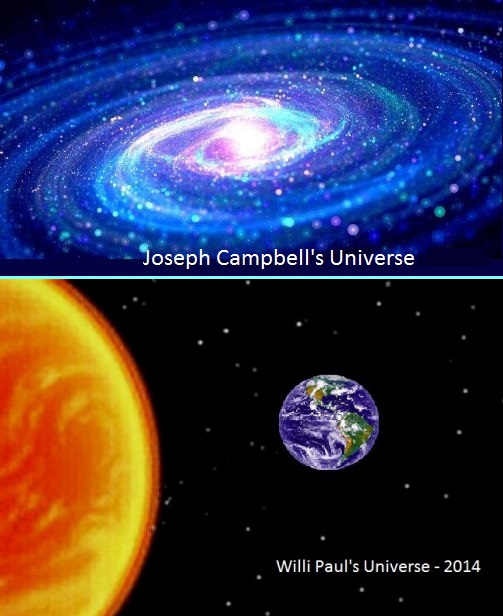
“Adding Resilience to Joseph Campbell's Four Functions of Mythology” - Vision by Willi Paul, openmythsource.com
"A million years after the birth of our sun, the violent explosion of a nearby supernova nearly ended life on Earth before it began. Over the next four and a half billion years, forces of nature shaped our planet and the life it harbored. Barely surviving the traumatic birth of the Moon, buffeted by supernovae, and bombarded by asteroids, the resilient Earth endured. And despite planet-freezing ice ages, devastating mass extinctions, and ever changing climate, life not only survived, it thrived. Today, we are told all life on Earth is threatened by a new peril - human-caused global warming."
Test, debate, recalibrate, incorporate, release, evaluate, integrate, re-test…. (W. Paul)
* * * * * * *
Mythology Scholar Joseph Campbell introduced one of his principal theoretical constructs in his Masks of God series. In Occidental Mythology, Campbell outlined the four functions of myth (wiki definitions are included ):
I. The Mystical Function
Mythology must inspire awe for the universe
Awe is an overwhelming feeling of reverence, admiration, fear, etc., produced by that which is grand, sublime, extremely powerful, or the like: in awe of God; in awe of great political figures.
II. The Cosmological Function
Mythology has to explain the shape of the universe
The cosmological argument is an argument for the existence of a First Cause (or instead, an Uncaused cause) to the universe, and by extension is often used as an argument for the existence of an "unconditioned" or "supreme" being, usually then identified as God. It is traditionally known as an argument from universal causation, an argument from first cause, the causal argument or the argument from existence.
III. The Sociological Function
Once we understand that nothing in nature lasts, we are free to design our own social order in accordance with that process. The sociological function validates this.
Sociology is the scientific study of social behavior, its origins, development, organization, and institutions. It is a social science that uses various methods of empirical investigation and critical analysis to develop a body of knowledge about social order, social disorder and social change.
IV. The Pedagogical Function
How to live under any circumstances
Pedagogy is the science and art of education. Its aims range from the full development of the human being to skills acquisition.
V. Adding the Resilience Function
Resilience is the innovative community code that can create and disseminate new values, re-focus our view on Nature and consumerism.
Psychological resilience is defined as an individual’s ability to properly adapt to stress and adversity. It can be learned and developed by virtually anyone. Resilience should be considered a “learned behavior.”
Resilience is protection, security and includes a community safety regime; eyes on the land.
Community-driven resilience circles connect us to the DIY and Transition movements. Many people in Circles highly value the natural world around them. For example, one group is working hard to protect the local bees by engaging in an educational campaign about which lawn treatments kill bees. They knocked on doors all around their neighborhood. Many groups value local food and farms. They join start community gardens.
How does resilience influence both current and potentially new archetypes and symbols? One example out of five:
Permaculture & Nature Archetype: Fear that global warming will destroy all life on Earth. Mistrust of business and goal of short-term profits
Symbols: Rising coastal tides, melting polar ice, coal fired power plants.
* * * * * * *
Our understanding and manipulation of the Universe has changed radically since the “awe and wonder” of the Campbellian era (see graphic). Clearly we require a new global pedagogy and a radical shift in how we deploy the old myths and create new ones.
Have you read the myth about global warming?
* * * * * * *
Planners must look more expansively at developing local initiatives. We have access to many of the solutions we need locally. Permaculture offers a pathway to a positive transition beyond sustainability to resilient communities and is an approach to designing human settlements and agricultural systems that are modeled on the relationships found in natural ecologies.
Comments